The Tramways of
Havana (La Habana)
BY
Allen Morrison
Ferro Carril Urbano de la Habana
Havana Electric Railway
Autobuses Modernos
see separate pages on the tramways of
Guanabacoa
Havana Province
Hershey Cuban Railway
This webpage is divided into two parts.
Part I covers the years between 1858 and 1928.
Part II considers the period from 1928 to 1952.
Part I: 1858-1928
The Cuban capital had one of the world's first street railways. The Ferro Carril Urbano de la Habana was chartered on 5 September 1857, began construction on 20 November 1857, and opened a horsecar line from the railroad station to the docks (Muelles) on 3 February 1858 [see map]. The first cars carried only freight - baggage and produce from nearby farms - but passenger vehicles were added on 20 September 1859. FCU had opened its first passenger line, to Carmelo, on 4 September 1859. Havana was the second city in Latin America to have a streetcar system, preceded only by Mexico City in January 1858. FCUH built passenger lines to Cerro and Jesús del Monte in 1862 and merged with a coach company to form the Empresa del Ferro-Carril Urbano y Omnibus de La Habana in 1863. By 1865 it was operating 32 passenger cars and 16 freight cars on 17 km of track. Here is a stock certificate [col. AM]:
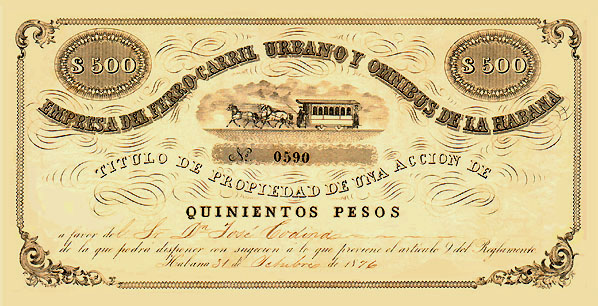
[This illustration was reproduced on a stamp pane in 2004: see Cuban Tram Stamps.]
The tram in the drawing is the type built by Eaton Gilbert & Co. in Troy, New York, which supplied the equipment for many of Cuba's steam railroads and probably built the first cars for Mexico City. But otherwise no genuine illustrations have been found of the trams that ran in Havana in the 1850s and 60s. About 1870 FCUOH began ordering streetcars from the John Stephenson Co. in New York. The stereocard below shows a Stephenson car passing Tacón Market on Calzada de la Reina (Av. Simón Bolívar) [see map] about 1890 [col. AM]:
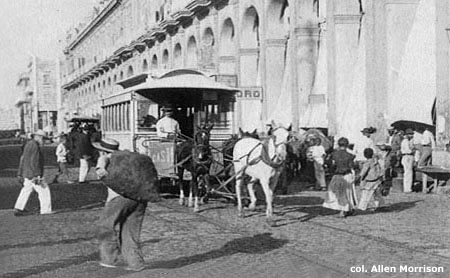
FCU also acquired large 8-wheel cars from Stephenson and a half-dozen steam locomotives from Baldwin, with which it replaced its horsecars on the Carmelo line in 1873 [see map] [from Harper's Weekly (New York), 6 May 1899, p. 450; courtesy Ken Fletcher]:
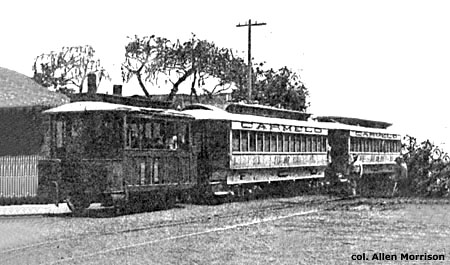
Streetcars on the other lines continued to be pulled by mules. FCU closed its Muelles (Docks) route because of congestion on the waterfront and built a new line to Castillo del Príncipe in 1882, but otherwise never enlarged its system - despite the fact that the city's population was approaching 300,000. In 1897 FCU secured permission to electrify its lines, but the plan was thwarted by Cuba's conflict with Spain. On 14 December 1898, two days after a treaty was signed in Paris that ended the Cuban-Spanish-American War, FCU sold its railway for 1,472,000 pesos to a syndicate of U.S., Canadian and French capitalists: 71 streetcars, 6 locomotives, 637 horses, 182 mules and 64 km of track. The foreigners gathered in New Jersey and formed the Havana Electric Railway Company on 7 January 1899.
HER began installation of an electric plant at once and on 4 April 1900 (a month after Cuba's first trolley system opened in Guanabacoa) ordered 110 single-truck electric cars from Jackson & Sharp Co. in Wilmington, Delaware, USA. This was one of the largest initial streetcar orders in history, anywhere. Here is a drawing of the J&S model for Havana. Note mounts for twin trolley poles [Street Railway Journal, New York, 4 August 1900, p. 725]:
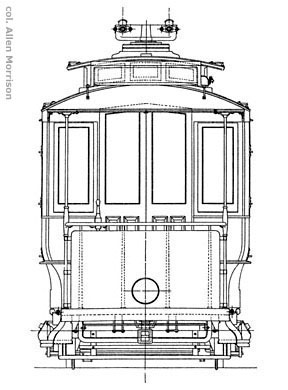
The photo below shows one of the cars that J&S built for the Havana Electric Railway. It has General Electric motors and a McGuire model A-1 truck [col. AM, courtesy Roy Budmiger]:
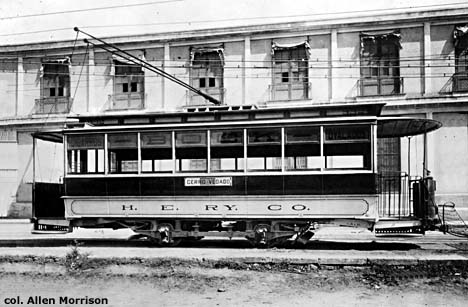
Like Guanabacoa, Havana chose the twin trolley system "because of the frequency of torrential rains . . . protection of the water mains and other underground pipes is secured by the requirement that the company shall employ the double overhead trolley which insulates the electric current from the earth" [Maj. W. M. Black: see bibliography below]. The governor also feared that "during periods of dry weather the rails would be covered with finely powdered lime dust . . . [which] would prevent good contact between the car wheels and rails" [Street Railway Review, Chicago, 15/10/1901, p. 755]. During the following decades Guanabacoa and Havana were among the few cities on earth that used twin poles on their trolley cars. HER inaugurated its first electric line, from its depot in Vedado to San Juan de Dios, on 21 March 1901. The postcard below shows a car at Tacón Market - in approximately the same spot as the horsecar on the stereocard above, but looking the other way [col. AM] [see map]:
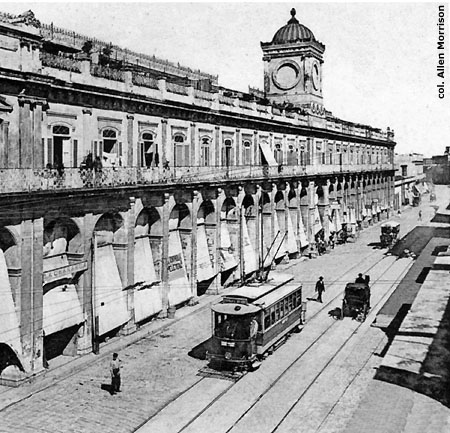
All 110 cars from Wilmington arrived by the end of 1901 and new electric lines opened all over town. Track gauge was standard 1435 mm. In 1902 HER formed a subsidiary, the Insular Railway, which built a suburban line to Marianao in 1903 [see map]. Another unusual aspect of Havana's trolley system was its elevated line over Calle San Pedro along the docks. This was the 8-block section that the horsecars had found too congested. The single-track structure between Calles Santa Clara and O'Reilly opened in January 1904: trolleys ran northbound only and stopped at an elevated station [see map]. These magazine illustrations show Havana's elevado from above and below [Cuba Review, New York, March 1906 and May 1904]:
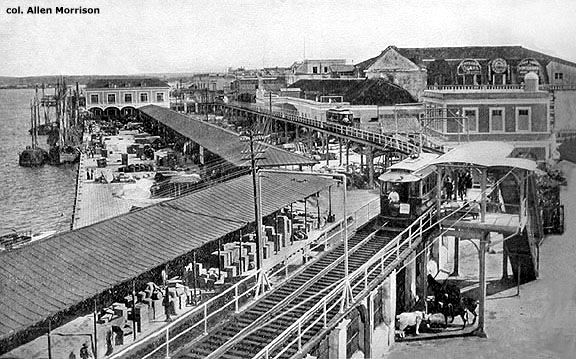
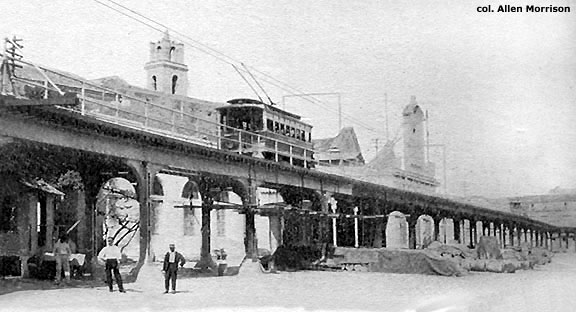
In 1906 HER began buying trucks from McGuire and motors from General Electric and building streetcars in Havana. The rare photograph below (Ebay cost: $301) shows an experimental open model with screened sides – the only such tram of its type in Cuba [col. AM]:
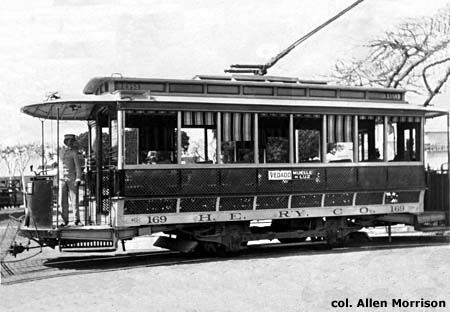
HER later purchased trucks from Brill and was operating 372 streetcars when it became part of the Havana Electric Railway, Light & Power Company in 1913. HERL&P's Annual Report for 1921 lists 495 closed passenger cars, an open car, a sightseeing car, 2 parlor cars, 8 freight locomotives, a motor box car, 2 locomotive cranes, 2 motor tower cars, 25 flat cars and 50 dump cars. The postcard below shows the sightseeing car, which was constructed in 1908 [col. AM]:
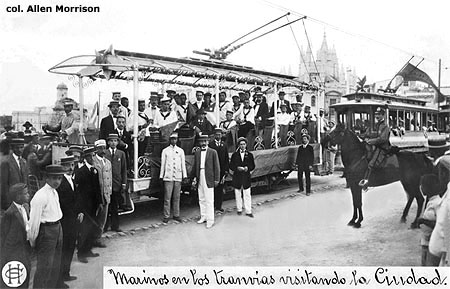
Havana Electric Railway also purchased 10 small battery-powered buses from Brill in 1917 [see photos on separate page]. In 1921 it built its first closed tram with an arch roof and nine side windows instead of eight - which it numbered 502. Thereafter all vehicles were built, and rebuilt, to that design. All passenger streetcars in Havana, throughout the system's history, were 4-wheel models 32 ft long x 7 ft wide (9.75 x 2.14 m) - the largest that could turn on the narrow downtown streets. Double-truck freight vehicles ran only between HER's shops in Vedado and a quarry in Marianao [see map]. The transfer below, from the 1920s, shows the new arch-roof model [col. AM]:
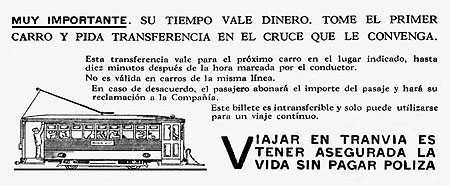
("VERY IMPORTANT. YOUR TIME IS WORTH MONEY. TAKE THE FIRST CAR AND ASK FOR A TRANSFER AT THE APPROPRIATE INTERSECTION . . . TRAVELING BY STREETCAR IS HAVING LIFE INSURANCE WITHOUT BUYING A POLICY")
In 1925 HERL&P was acquired by the U.S. holding company Electric Bond & Share, which also acquired railway, light and power operations in Camagüey and Santiago. Havana Electric Railway Company reorganized in Maine in 1926 and regained control of its railway operations in 1928, after which "Ebasco" ran only the power sector. On the eve of the Depression there were 578 streetcars running on 244 km of track in Havana. Here is a later type of transfer that listed the routes [col. AM]:
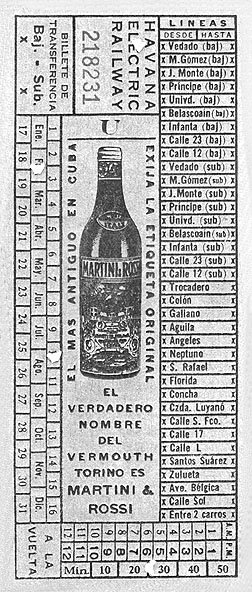
And here is an HER token [col. AM]:
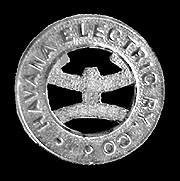
go to
Part II: 1928-1952
go to
INTRODUCTION & INDEX MAP
Copyright © 2002-2102 Allen Morrison - ALL RIGHTS RESERVED
|












